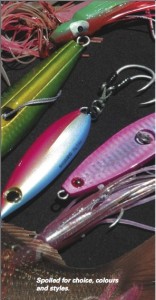There is no doubt there is a significant proportion of the fishing fraternity in New Zealand who love to fish with lures. Certainly, the salmon fishermen of the south and trout fishers throughout the country are well versed in the art of lure fishing. Salt water lure fishing was a bit slower off the mark, although it may surprise some to know that this form of salt water fishing goes back well over thirty years. I can remember when Bruce Riley and a mate developed and produced a chromed metal jig back in the late seventies and had great success with them in Auckland’s channels and throughout the Hauraki Gulf. These were closely followed by jigs from Lethal, then Grim Reaper, which are still available today. At about the same there were dabblings in rubber lures by Kilwell with the Mister Twister range and Just Fishing brought in a range of American bass worms but neither of these really took off. Maybe it was just too early for the NZ fishos to get their head around how to use them, but those chrome metal jigs sure did and lure fishing for snapper was born.
The Present Day

There is a country to the north of us that has a lot of very similar parallels to New Zealand, a country made up of a group of long islands just like us and like us they also love fishing. Snapper is a sought after catch in their waters although their snapper are a lot smaller than ours. But the Japanese differ from the laid back Kiwi approach to fishing in that they are very intense and every facet is studied to the nth degree –almost to the point of being pedantic about it.
This is maybe because there’s a lot less fish to go around a lot more people and they have to become very good at what they do. The outcome is they produce some of the best tackle designers, innovators and manufacturers in the world and now we are reaping the benefits of Japanese research and development in the manufacturing of rods, reels, lures, hooks and general tackle to a standard never seen before.
So let’s have a look at what lures are available, how and where they are used and also the tackle to get the best out of these lures.
The Original Chrome Jig
The original Kiwi made snapper jigs as I said appeared in Auckland in the late seventies and were fish-shaped, with the main weight in the tail, and having either a single or triple hook on the tail. They came in a range of weights from 25g up to 200g. Later, the Grim Reaper range came in a multitude of colours attractive to fish.
Soft Baits
2003 when a reintroduction by a company called Pure Fishing with its range of Gulp scented tails that things really took off. But it wasn’t just these tails that captivated Kiwi fishermen, it was the full range of equipment that came with them. Now at last everything had come together; lightweight graphite spinning rods, small high-tech spinning reels with powerful ultra smooth drags, non-stretch braid line, fluorocarbon leaders and proper jigheads.
Slow Jigs
Now comes the Japanese influence, some of which has come from their custom commercial fishing industry. The first to turn up was the Lucanus from Shimano, which proved to be a great deeper water tool if used in about 20m plus, but it took a little while to get out of the Japanese how to use them. As it turned out, all this total group of lures are fished pretty much the same way. Following after the Lucanus came the Bottomship jig, also from Shimano and at the same time the amazing Inchiku jigs from a raft of different companies.
Flutter Bugs & Kaburas
These are the next new boys on the block and yes they do catch fish big-time. Just like you would expect from the Japanese lure industry, the flutter bugs look like an Inchiku lure that has been run over by a steamroller, giving it a wide, flat body which makes it flutter slowly as it drops down through the water column. Hence the name flutter bug. Kaburas are different again. Imagine an 85g ball sinker with two sides cut off, painted in different coloured bright enamel paint, with eyes glued to the cut-off sides, with hooks and skirts very similar to the Lucanus. The main difference with this lure is it has a hole through it, which the leader passes through then attaches to the hooks and skirt. The head can move up and down the leader just like a sinker.

Spoiled for Choice
So there you have it. There are lots to choose from in a range of weights for varying depths and currents and these are just the snapper lures. There is another range for kingfish and specialised tackle for that, but that’s another story.




